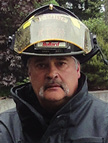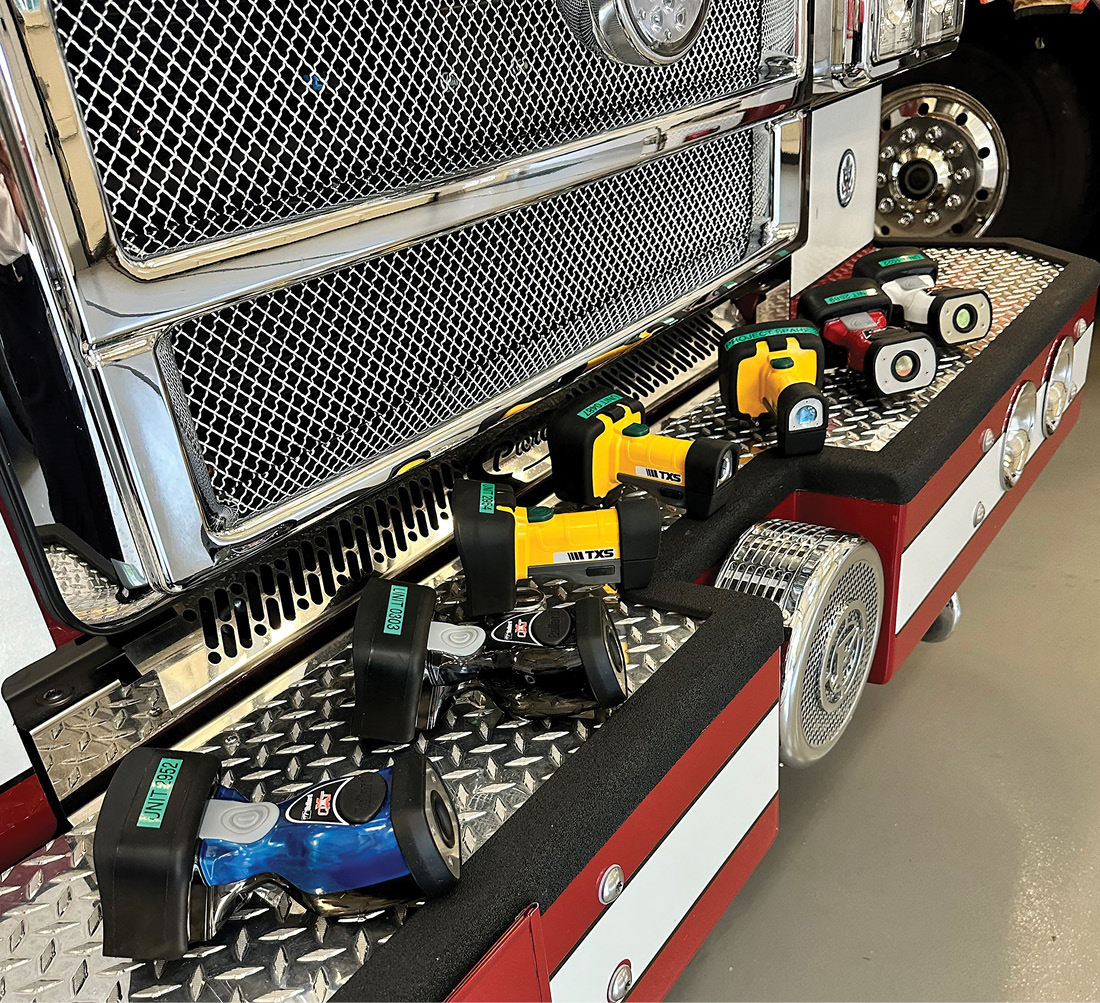When have fire department members ever said that they have too much equipment, or you heard them say, “Sorry, Mr. Mayor, but our compartments are full!”? The opposite is what happens.

More equipment is required because of age [National Fire Protection Association (NFPA) 10-year replacement requirement] plus whatever gets damaged or lost in an incident. Today’s budgets are getting stretched thin because of rising costs, budget cuts, and supply chain issues.
So, let’s get back to the topic of this month’s article: How many thermal imagers (TIs) does your fire department require? Let’s delve back to the beginning, when TIs were first available to the fire service. Do the words “large, cumbersome, heavy, expensive, poor image quality, white out, poor battery runtime, unreliable vehicle charging stations, lack of durability, and confusing to use” come to mind or ring a bell?

1 Multiple types and assorted colors of TIs. [Photo courtesy of the Cary (NC) Fire Department.]
I am humbled in my role as a trainer to get to travel where I do and work with so many fire departments worldwide. But, it is what I see and hear that can be shocking—either good or bad. From small volunteer to large city center fire departments and from rags to riches, they all share the same common denominator: They could use more TIs.
So, what are the two types of TI options available to the fire service today?
First, there are situational awareness TIs. These TIs have lower resolution (160×120); slower processor/refresh rate (9 to 15 Hz); solid colorization; short ranges of visibility and measurement (generally 7 to 10 feet or 2 to 4 meters); and lower distance to spot ratio, which means they are only able to accurately measure or determine a heat source at a relatively close distance such as 10 feet away.
These smaller TIs should not be used for exact temperature readings, size-up, search and rescue, directing hose streams, or evaluating structural stability/integrity. They can be used for staying oriented, locating the fire, locating other firefighters, and locating egress points.
Second, there are advanced decision-making TIs. These TIs offer higher resolution (320×240), fast refresh rate of 26 to 60 Hz, wider field of view, low thermal sensitivity [noise equivalent temperature difference, <30 milli Kelvin (mK) to 70 mK], more accurate temperature range, and image enhancement that provides a transparent IR image.
They provide high dynamic range (0°F to 1,200°F or up to 650°C), super red-hot colorization (yellow, orange, and red), larger display screen size, and universal NFPA screen symbols (e.g., high gain/low gain indicator and temperature reference bar). They produce a more detailed image, allow for better decision making, and can monitor temperature progressions. All of these items could be missed with a lower resolution TI with slower refresh rate.
Advanced decision-making TIs can be used for size-up and locating the source and seat of the fire; search and rescue and to identify potential victim locations; fire attack to identify the severity of the fire; overhaul to identify hottest and coldest areas for predicting fire spread and travel; evaluating and monitoring structural stability and integrity and identifying building layout and room configuration (holes in floors); smells and bells—i.e., overheated ballasts and electrical breakers (more accurate temperature measurement); and life-saving and tactical decision making.
Summing all this up comes down to one main factor, which is cost! The bottom line is, how many TIs can you purchase with an allotted amount of money? Do you require a TI for every riding position for every apparatus within your fire department, or one TI for the officer in the apparatus, or one per fire station? Ask yourself: What is your call volume? What types of calls does your fire department respond to? What is your staffing? Do you find yourself doing more with less? Are you experiencing staffing reduction because of retirement, the fire department not hiring fast enough, or community growth that makes it difficult to keep up with additional responses?
A fire service TI is a handheld device used by firefighters to detect and visualize heat signatures made visible on a display screen. It works by detecting infrared radiation (heat) emitted from objects and producing a heat signature type image that can help firefighters locate and identify sources of heat, such as fires or hot spots. TIs help firefighters navigate through smoke-filled environments with greater ease, locate victims, and pinpoint areas where fire is most likely to spread and can confirm total extinguishment for due diligence. So, how many TIs does your fire department require? I know that some fire departments have purchased situational awareness TIs for every firefighter but do not have any advanced decision-making TIs. Was this the right choice? Have they put their firefighters in harm’s way? Have they opened themselves up to potential liability or possible loss of life?
These two types of TIs are not the same and cannot be used the same way, nor do they provide the same information. Do not be fooled by “I can get more for less.” There is a place for situational awareness TIs, and that is for firefighter safety!
As a firefighter or officer, you have been tasked with a job of significant importance, and you need all the tactical and accurate information to make potentially lifesaving decisions. Make sure you do your due diligence and outfit your fire department with the appropriate number of TIs to keep up with the demands of your growing communities.
MANFRED KIHN is a 19-year veteran of the fire service, having served as an ambulance officer, emergency services specialist, firefighter, captain, and fire chief. He has been a member of Bullard’s Emergency Responder team since 2005 and is the company’s fire training specialist for thermal imaging technology. He is certified through the Law Enforcement Thermographers’ Association (LETA) as a thermal imaging instructor and is a recipient of the Ontario Medal for Firefighters Bravery. If you have questions about thermal imaging, email him at Manfred_kihn@bullard.com.

